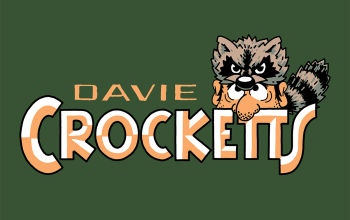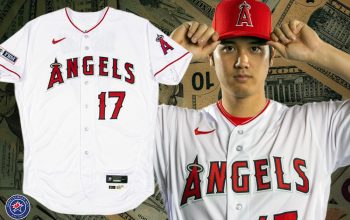
The Single-A Chicago White Sox affiliate in Kannapolis, North Carolina, will have a new name in 2020. Just moments ago, the team announced it will be the Kannapolis Cannon Ballers, an homage to the textile plant Cannon Mills. The team’s identity, designed by Dan Simon of Studio Simon, centers around a human cannonball character who is meant to personify the adventurous spirit of the area.

When the new owners of the Kannapolis Intimidators announced that the team would be taking on a new name to go with their new stadium in 2020, the reaction was predictably mixed. Their existing nickname was a tribute to Kannapolis’s favorite son, NASCAR driver Dale Earnhardt, who purchased the team after the 2000 season, just months before his untimely death during the Daytona 500 in February 2001.
“He’s one of the most beloved individuals in the history of NASCAR racing,” said Dan Simon of Studio Simon, who was charged with the considerable task of creating the brand that would replace the Intimidators.

The nickname Intimidators needed to be replaced largely because, while the team had permission to use it, it was still associated with and in many ways belonged to the late race car driver’s estate. There were limitations on the team’s ability to trademark elements of the brand, and that hamstrung the new owners’ ability to truly make it their own.
“We were very conscientious of not coming in and changing everything for the sake of changing,” said Alicia Amling, Chief of Staff for Temerity Capital Partners, and their offshoot, Temerity Baseball, which purchased the team after the 2018 season. “We really wanted to be thoughtful and careful before we just dove in. It was intimidating to think about getting rid of the Intimidators moniker. But ultimately it was the only practical business decision we could make.”
Kannapolis is the first team that Temerity Baseball has owned, and in developing Kannapolis’s new brand, the new owners wanted to honor the culture that has embraced Earnhardt so thoroughly.
“I presented about 10 names to the team,” Simon said. “The majority of the names had some kind of a racing or car culture connection. The car culture and the racing culture are very big there, and the connection to Dale Earnhardt specifically is huge.”

While the current culture in the town focuses heavily on auto racing, the town has its origins in the textile industry. In the late 1800s, James W. Cannon founded the Cannon Manufacturing Company, which would become Cannon Mills, at one time the largest manufacturer of towels in the world. Until the early 2000s, it was basically the main reason for Kannapolis’s existence.
“The city was built because of the mill,” Simon said. “Everything there centered around the mill. The downtown was built to give the people who worked at the mill places to shop for food and clothing. There was a movie theater for the people who worked at the mill.”
In fact, the very name of the city derives from, “Cannon-opolis,” which is what it was called by early employees at the textile plant and journalists in the area. Cannon-opolis would become Kannapolis (with a K to avoid confusion with nearby Concord, North Carolina). After more than a century in business, the mill succumbed to automation and outsourcing and it closed in 2003, taking thousands of jobs with it. More than a decade after it closed, though, it’s obviously still an important part of the city’s identity.

When Simon first started working on the brand, he visited Kannapolis, meeting with business leaders, ticket holders, and team officials, hoping to find a clear direction on whether to incorporate the history of the mill into the team’s identity.
“I was hoping,” he said, “that I would find out was whether the consensus was, look, yeah we’re kind of reinventing things here in Kannapolis but you can’t make the mill history go away, so this identity should reflect that mill history—OR, the other side of the coin, that’s the past, we’re looking ahead to the future, we want a unique identity that’s not tied to the mill.”
There would be no such consensus, though.
“What I got instead,” Simon said, “was basically half the people saying, DEFINITELY a mill identity, and the other half of the people, DEFINITELY NOT specific to the mill, we’re moving on.”

In coming up with a new nickname, there were certain parameters the team kept in mind.
“It had to be local, unique, and fun,” Amling said. “Those were the three guiding principles. Frankly, just hitting those three was a very difficult task. We got rid of a lot of names because they didn’t hit all of those.”
Local residents, perhaps seeing the trends in minor league baseball, had one more requirement.
“They said, we don’t want any of those weird names,” Amling said. “When we talked to people at the ballpark, they said, not one of those weird names!”
The team agreed that there was a reason not to follow the path of overt wackiness forged by the likes of the Chihuahuas, Jumbo Shrimp, and Rumble Ponies in recent years: “Is there any more badass name than Intimidators?” Amling asked. “We didn’t want to go way too far in the other direction.”
So with a handful of parameters, a history tied to the textile industry, and a tradition of racing culture in the town, the team explored possibilities. A name-the team contest had turned up lots of options related to the mill and to NASCAR, but nothing that was striking just the right chord.
The name Cannons came up frequently in the name-the-team contest, but between the fact that the name has been used by other teams and that it has an association with violence (“There’s no denying the fact that a cannon is a weapon of war,” Simon said) it was not exactly reflective of minor league fun, so they moved on from that idea.

Then, Simon had a moment of inspiration: “I was thinking, how do we turn the cannon into a benign cannon, not a weapon of war? At first I thought of those T-shirt cannons that so many minor league teams use, that’s kind of like a little cannon, and then I thought, wait a second … the HUMAN CANNONBALL!”
With that, they were off and running.
“What this one did was, it used the Cannon name, which the team liked anyway, and which a lot of the suggestions from the community were,” Simon said, “but it now turned it into something that was not war related, and it was fun. In minor league baseball, which is often said to have a carnival-like atmosphere, it was perfect!”

The character in the logo is a human figure with a baseball head—in the storied tradition of baseball-headed mascots like Mr. and Mrs. Met, Mr. Redlegs, Rosie Red, and Homer the Brave, to name a few—but this guy, who is nameless for now, is also a human cannonball.
“He’s a baseball, and his body is made small because we want to focus on the baseball,” Simon said. “And also, it’s more fun that way.”
“I’ve been calling him my little guy,” Amling said.

Even though the little guy is a carnival performer, the character (both in logo form and as a mascot) still has ties to the area’s racing culture. To start, with his helmet and goggles, he just kind of looks like a race car driver. But there’s more.
“The whole human cannonball thing, we’re talking about an extreme endeavor,” Simon said, “and certainly racing, the spirit of Dale Earnhardt, the guy who takes chances, or puts it all on the line every time he goes out there—that’s something that Dale Earnhardt did, and that’s something that human cannonballs do every time they get shot out of that cannon.”

Even more specifically, there’s one very important element of the design that pays tribute to the team’s former namesake.
“That mustache is an homage to Dale Earnhardt,” Simon said. “My original thumbnail sketch of that character had a handlebar mustache because my first thought was, if there were to be a cartoon or a period movie about a human cannonball, he’d probably have a handlebar mustache. When I showed that rough sketch to the team, they said, hey, we’ve got to make this look like Dale’s mustache.”
One more connection to racing is that the name evokes the movie Cannonball Run, the 1981 action-comedy about a cross-country car race. (I mentioned to both Simon and Amling that I really hope every time the team scores, they’ll announce over the PA, “That’s another Cannonball Run!” I will await my royalty checks for the idea.)

Finally, the nickname Cannon Ballers allows for an alternate jersey that will feature the shortened moniker “Ballers,” which, Simon explains, is “a phrase used nowadays not just for athletes but also for people. If somebody is really cool or got everything together, he’s a baller.”

The Cannon Ballers (whose brand I predict will be wildly popular) will first take the field April 9, 2020, when next year’s South Atlantic League season begins.








